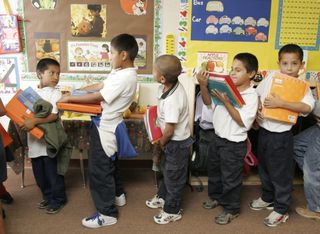Hispanic children are getting most nutrients, but eating too much fat
The Hispanic community has its own set of health challenges, including high rates of diabetes, plus kidney and cardiovascular disease. Children aren’t immune — according to the National Health and Nutrition Examination Surveys, from 2005 through 2006 Mexican American children age 2 through 19 were the heaviest among all ethnic and racial groups in the U.S.
Just how their diets break down is the subject of a study in the June issue of the Journal of the American Dietetic Assn., which analyzed the nutrition quality in diets of 1,030 normal weight and overweight Hispanic children age 4 to 19 in Houston who had low socioeconomic status. Quality was assessed using the Dietary Guidelines for Americans, published jointly by the Department of Health and Human Services and the Department of Agriculture.
Overall, the diets of all children were adequate in most nutrients, but often surpassed the guidelines for total fat, saturated fat, cholesterol, and added sugar and salt. Looking more closely at the foods the kids ate, 68% of calories came primarily from soda, desserts, pizza, chips, fruit drinks, fruit juice, processed meats and burgers. About one-fourth of the children went over the maximum intake level of 25% for added sugars.
All kids came up short on fruits and vegetables — the average number of servings they ate was lower than the Dietary Guidelines for Americans recommendation. They also fell below standards on consumption of vitamins E and D, pantothenic acid, calcium, potassium and fiber.
Several factors put the Hispanic population at higher risk for obesity. In this study, 91% of parents were overweight or obese, and parents’ income and education levels were low. Other issues reported in the NHANES study include limited health insurance coverage, acculturation to American diet and lifestyle, recent immigration, and access to medical care.
Researchers from the Baylor College of Medicine wrote in this study: “Knowledge of the dietary intake of children from low-[socioeconomic status] Hispanic families at high risk for obesity will provide a basis on which to build nutritional interventions and policy that are appropriately tailored to population subgroups.”
Source: Los Angeles Times – Health
By Jeannine Stein
Photo credit: Francis Specker / AP




